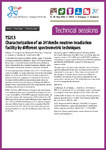
Please use this identifier to cite or link to this item:
http://ricaxcan.uaz.edu.mx/jspui/handle/20.500.11845/722Full metadata record
| DC Field | Value | Language |
|---|---|---|
| dc.contributor | 6207 | es_ES |
| dc.contributor.other | https://orcid.org/0000-0002-7081-9084 | es_ES |
| dc.coverage.spatial | Global | es_ES |
| dc.creator | Gallego Díaz, Eduardo | - |
| dc.creator | Amgarou, Khalil | - |
| dc.creator | Bedogni, Roberto | - |
| dc.creator | Lorente, Alfredo | - |
| dc.creator | Mendez, Roberto | - |
| dc.creator | Vega Carrillo, Héctor René | - |
| dc.date.accessioned | 2019-03-13T15:37:19Z | - |
| dc.date.available | 2019-03-13T15:37:19Z | - |
| dc.date.issued | 2012-05 | - |
| dc.identifier | info:eu-repo/semantics/publishedVersion | es_ES |
| dc.identifier.uri | http://localhost/xmlui/handle/20.500.11845/722 | - |
| dc.identifier.uri | https://doi.org/10.48779/gqkn-q143 | es_ES |
| dc.description.abstract | An automated panoramic irradiator with a 3 Ci 241Am-Be neutron source is installed in a bunker-type large room at the Universidad Politécnica de Madrid (UPM). It was recently modified and a neutron spectrometry campaign was organized to characterize the neutron fields in different measurement points along the irradiation bench. Four research groups working with different Bonner Sphere Spectrometers (BSS) and using different spectral unfolding codes took part to this exercise. INFN–LNF used a BSS formed by 9 spheres plus bare detector, with cylindrical, almost point like, 6LiI(Eu) scintillator (4 mm x 4 mm, from Ludlum); UAZ-UPM employed a similar system but with only 6 spheres plus bare detector; UAB worked with a 3He filled proportional counter at 8kPa filling pressure, cylindrical 9 mm x 10 mm (05NH1 from Eurisys) with 11 spheres configuration; and CIEMAT used 12 spheres with an spherical 3He SP9 counter (Centronic Ltd., UK) with very high sensitivity due to the large diameter (3.2 cm) and the filling pressure of the order of 228 kPa. Each group applied a different spectral unfolding method: INFN and UAB worked with FRUIT ver. 3.0 with their own response matrixes; UAZ-UPM used the BUNKIUT unfolding code with the response matrix UTA4 and CIEMAT employed the GRAVEL-MAXED-IQU package with their own response matrix. The paper shows the main results obtained in terms of neutron spectra at fixed distances from the source as well as total neutron fluence rate and ambient dose equivalent rate H*(10) determined from the spectra. The latter are compared with the readings of a common active survey-meter (LB 6411). The small differences in the results of the various groups are discussed. | es_ES |
| dc.language.iso | eng | es_ES |
| dc.publisher | Radiation Protection Association (IRPA) | es_ES |
| dc.relation | http://www.irpa.net/page.asp?id=54516 | es_ES |
| dc.relation.uri | generalPublic | es_ES |
| dc.rights | Atribución-NoComercial-CompartirIgual 3.0 Estados Unidos de América | * |
| dc.rights.uri | http://creativecommons.org/licenses/by-nc-sa/3.0/us/ | * |
| dc.source | 13th International Congress of the International Radiation Protection Association (IRPA) | es_ES |
| dc.subject.classification | CIENCIAS FISICO MATEMATICAS Y CIENCIAS DE LA TIERRA [1] | es_ES |
| dc.subject.other | Neutron spectrometry | es_ES |
| dc.subject.other | neutron dosimetry | es_ES |
| dc.title | TS2f.5 Characterization of an 241AmBe neutron irradiation facility by different spectrometrictechniques | es_ES |
| dc.type | info:eu-repo/semantics/conferenceObject | es_ES |
| Appears in Collections: | *Documentos Académicos*-- UA Ciencias Nucleares | |
Files in This Item:
| File | Description | Size | Format | |
|---|---|---|---|---|
| Characterization of a 241.pdf | 569 kB | Adobe PDF |  View/Open |
This item is licensed under a Creative Commons License
